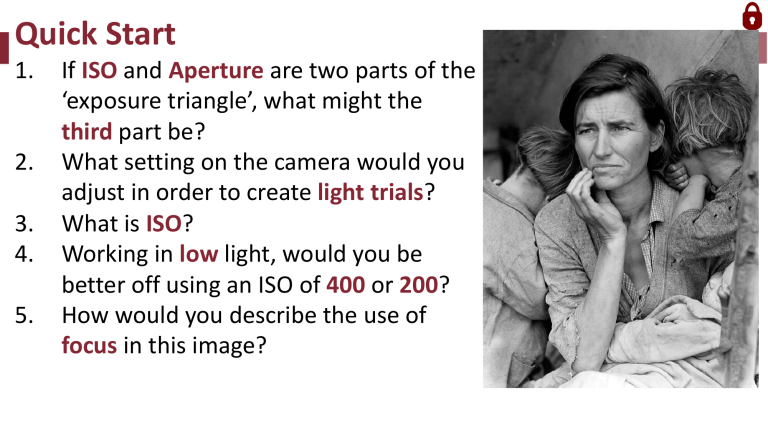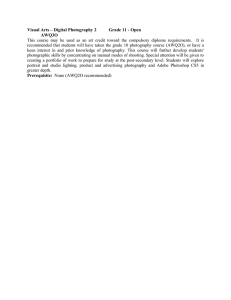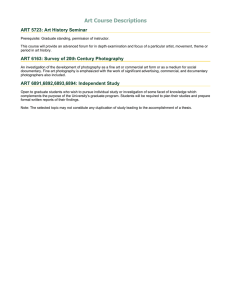
Quick Start 1. 2. 3. 4. 5. If ISO and Aperture are two parts of the ‘exposure triangle’, what might the third part be? What setting on the camera would you adjust in order to create light trials? What is ISO? Working in low light, would you be better off using an ISO of 400 or 200? How would you describe the use of focus in this image? Introduction to th 20 & st 21 C. Photography A-Level Photography: Foundation Studies 18 January, 2022 Learning Intention: Knowledge indicators: Students will learn about the different genres of photography qPhotography is divided into genres q‘How to read’ a photograph, explore narrative and content as well as evaluating its effectiveness Students will learn to ‘read’ a photograph, explore narrative and content. Skill indicators: qTo analyse and recognise elements of photography in order to produce effective imagery 1.Portrait Photography § Aims to capture the personality and mood of an individual or group. § Images may be candid or posed, full body or close-ups Sometimes I think all my pictures are just pictures of me. My concern is... the human predicament; only what I consider the human predicament may simply be my own. Richard Avedon (1923-2004) • Diane Arbus (1923-1971) focused on questions of identity and people living on the fringes of society. • She photographed people who she saw as creating their own personal identities like performers, twins, and transvestites. • She photographed subjects that were until that time forbidden. “Often the most seemingly ordinary people are the most fascinating,” Jet Swan Pablo Picasso by Robert Doisneau (1912-1994 Do you notice anything unusual about this photograph? § Documentary photography § A straightforward and accurate representation of people, places, objects and events, and is often used in reportage § Until the mid-twentieth century, documentary photography was a vital way of bearing witness to world events: from shoot-fromthe-hip photographs of the Spanish Civil War by Robert Capa to the considered portraits of poor farmers by Dorothea Lange ‘I saw and approached the hungry and desperate mother, as if drawn by a magnet. I do not remember how I explained my presence or my camera to her, but I do remember she asked me no questions. I made five exposures, working closer and closer from the same direction. I did not ask her name or her history. She told me her age, that she was thirty-two. She said that they had been living on frozen vegetables from the surrounding fields, and birds that the children killed. She had just sold the tires from her car to buy food. There she sat in that lean- to tent with her children huddled around her, and seemed to know that my pictures might help her, and so she helped me. There was a sort of equality about it.’ Lange, 1960 ‘If your photographs aren't good enough, you're not close enough’ Robert Capa ‘Seeing, looking at what others cannot bear to see is what my life is all about’ Don McCullin § Social documentary photography § The camera as a tool for social change § Shedding light on injustice, inequality and the sidelined aspects of society. Martin Parr: The photographs comprising The Last Resort were taken between 1983 and 1985, a period of economic decline in northwest England. They depict a seaside resort past its prime with attractions designed to appeal to an economically depressed working class: overcrowded beaches, video arcades, beauty competitions, tea rooms and chip shops. 'It might be said that twilight is a muddled form of clarity. The warm glow that suffuses the ' golden hour' in Los Angeles acts to filter the grim realities, the outright lies, the selfdeceptions, which allow Hollywood, and by extension, America to flourish. 'Twilight' provides the rose-coloured glasses that make it possible to see out but not see in.' Philip-Lorca diCorcia Alex Prager Philip Lorca DiCorcia Here are two examples of photographic portraiture referencing cinema. They suggest narratives and archetypes that would be recognisable to any regular cinema-goer. These images appear as if isolated moments from a longer narrative. What do you imagine to be happening / to have happened – and how do the technical aspects contribute to your interpretation? ‘To me, photography is the simultaneous recognition, in a fraction of a second, of the significance of an event' Henri Cartier-Bresson One of the masters of street photography was Henri Cartier-Bresson. He coined the phrase ‘the decisive moment’, a moment in time (not a millisecond before or after) that would capture an image and give it true meaning. Street Photography Until the mid-twentieth century, documentary photography was a vital way of bearing witness to world events: from shootfrom-the-hip photographs of the Spanish Civil War by Robert Capa to the considered portraits of poor farmers by Dorothea Lange Social documentary photography During this period the tradition of documentary photography was reinvented. Artists began to see the camera as a tool for social change, using it to shed light on injustice, inequality and the sidelined aspects of society. However, social documentary photography is often a subjective art and not all photographers in this category intend their images to aid the bettering of society. Fan Ho (1931 – 2016) documented the Hong Kong street scene in the 1950s and 1960s. The city at the time was a very different place to what it became later in the century. He photographed the everyday life of children and workers in the side streets of the city. His photos are masterpieces of light and shadows; shapes and action. This leads some to call him the “Cartier-Bresson of the East”. Maier captured moments of street life, mostly in Chicago during the 1950s and 1960s. Her photos have a sense of gentleness and sometimes whimsy. Her subjects were diverse. She photographed children, the working class, and the wealthy on the street. She shot anything that caught her eye, including herself. There are many selfportraits in the collection; captured in reflections. § Photojournalism Photojournalism is a way of telling the story of a newsworthy (perhaps even historic) event or scene through photographs. Photojournalism should be as objective and truthful as possible and capturing candid moments as they happen is more important than getting picture-perfect shots. William Klein (1928 – ) is an American-born, French-based street and fashion photographer. He often mixes the genres by photographing high fashion models on the streets. Klein shoots with a wide-angle lens in a quick and energetic style. His urban photography shows motion blur and grain. His is a world off-centre. 3. Fashion Photography § Fashion photography showcases and glamorizes fashion clothing, shoes, and accessories to make them more desirable to consumers. It is commonly published in magazines and online. § Fashion photographers utilize many of the same skills as portrait photographers and must practice good teamwork and communication when working with shoot stylists, creative directors, and models. Guy Bourdain Narrative David Sims Mert Alas and Marcus Piggot Turkish and British Duo. What is the Narrative? Steven Meisel What is the narrative? What is the narrative? Still Life Photography § Features inanimate objects—natural or manmade. § Object selection, arrangement, and lighting are key to getting a great shot. After Dinner Games (1947)– Irving Penn Edward Henry Weston (March 24, 1886 – January 1, 1958 • 20th-century American photographer and Olympic archer. He has been called "one of the most innovative and influential American photographers..." and "one of the masters of 20th century photography." Landscape Photography Ansel Adams American landscape photographer and environmentalist. He helped found Group f/64, an association of photographers advocating "pure" photography which favoured sharp focus and the use of the full tonal range of a photograph Andreas Gursky A German artist known for his large-scale digitally manipulated images. Similar in scope to early 19th-century landscape paintings Independent Learning: § Students are to produce a presentation about the different genres of photography looked at today § You will then pick one of the photographers to research more fully and write a piece about them and their style, illustrated with imagery of their work. § You may pick another photographer from websites listed in your ‘One Note > Research’ folder, as an alternative. Learning Summary: 1. Name the genres of photography? 2. Name a photographer from one of the genres? 3. Can you describe a genre by reffering to how a photographer might use the elements of the exposure triangle to achieve their image? 12D-Px1 - Photography Notebook (Web view)




